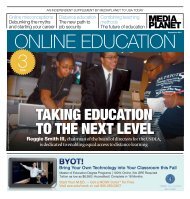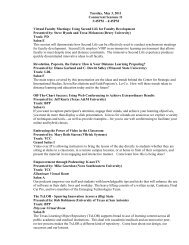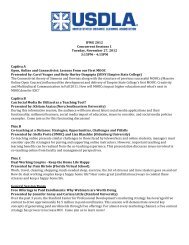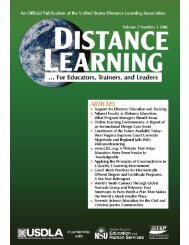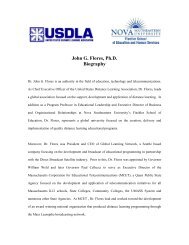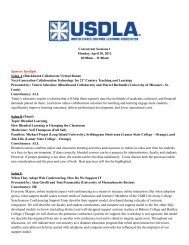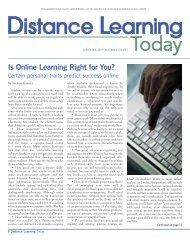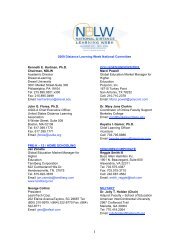United States Distance Learning Association
United States Distance Learning Association
United States Distance Learning Association
- No tags were found...
You also want an ePaper? Increase the reach of your titles
YUMPU automatically turns print PDFs into web optimized ePapers that Google loves.
Table 5.<br />
Continued<br />
Administrative Structure (continued)<br />
Barriers Solutions Cases<br />
Marketing and sustaining<br />
the program<br />
• Provide constant and similar messages via multiple channels,<br />
such as management and team briefings, high quality<br />
catalogs, a video of site information and resources<br />
• Distribute an organizational newsletter, flyers and wall<br />
posters<br />
• If special infrastructure is built, remember that planned<br />
maintenance and resources are needed to sustain the network<br />
over its lifetime<br />
• Host an open house for the program<br />
• Reassign or reuse existing media where cost effective, rather<br />
then installing new systems without considering existing<br />
ones<br />
Vendor management • Select vendors by using open system and open standard<br />
• Evaluate vendor performance regularly.<br />
4, 5, 24, 27<br />
18, 27<br />
Organizational Change<br />
Barriers Solutions Cases<br />
Organizational support to<br />
have a shared vision and<br />
infrastructure<br />
Organizational learning<br />
culture against DE and<br />
constructivist learning.<br />
Planning and delivering<br />
DE programs<br />
• Conduct strategic planning and announce the DE policy<br />
• Solidify the initiative with management and demonstrate<br />
support from corporate executives<br />
• Convince and solicit support from the corporate executive<br />
through educating them<br />
• Have a forum, workshop, or seminar for staff and managers<br />
to facilitate their understanding about DE and to hear their<br />
expectations about DE<br />
• When using teaching methods or styles that have not been<br />
used in the organization in the past, provide a “bridge” to<br />
the new methods and processes<br />
• Articulate the mission of the online distance education program.<br />
• Build infrastructure<br />
• Provide operating guidelines and standards<br />
• Develop templates, processes, and systems to enhance the<br />
quality<br />
• Pay special attention to realistic expectations for distance<br />
education in a non-Western culture<br />
3, 6, 7, 11, 14, 25,<br />
27, 30<br />
3, 10, 14, 15, 16, 19,<br />
23<br />
9, 22, 23, 24, 32<br />
Evaluation/Effectiveness<br />
Barriers Solutions Cases<br />
Evaluation of courses and<br />
programs<br />
Assessing and tracking<br />
learners’ achievement<br />
• Plan the collection of information, feedback, and evaluation<br />
before, during and after the program<br />
• Host a seminar with students and DE team to get feedback<br />
about program<br />
3, 4, 5, 6, 8,<br />
17, 24, 25, 29<br />
• Conduct both formative and summative evaluation 13, 18, 20, 27, 28<br />
Table continues on next page.<br />
10 <strong>Distance</strong> <strong>Learning</strong> Volume 4, Issue 4



